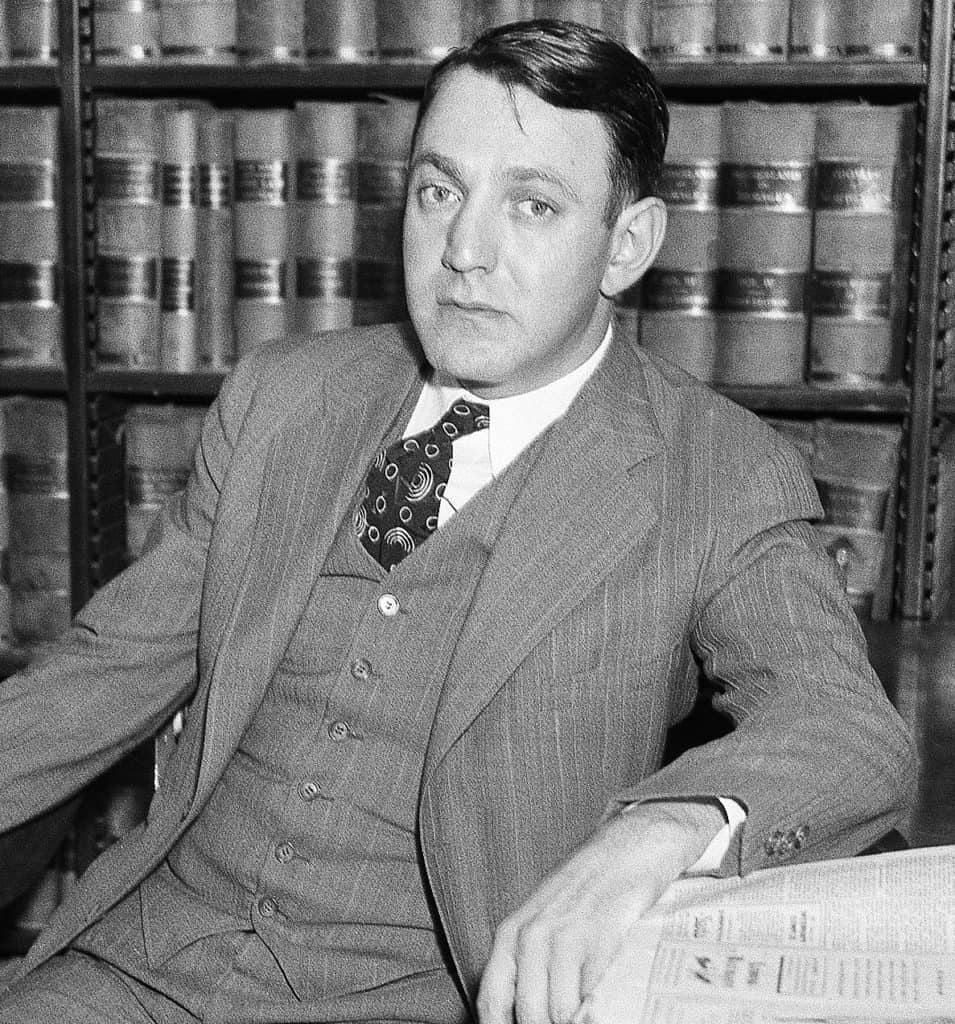
How is it possible for all of this to be done without being seen? Is everyone is Yonkers blind? Or is everyone in Yonkers in on the secret?
US Attorney Watts, 1930
By Dan Murphy
A few months ago, we wrote about Avram Davidson, a famous Science Fiction author who grew up in Yonkers. In addition to his Sci-Fi books, Davidson wrote a short story titled “Beer Like Water,” about the case in Yonkers in 1930 when hoses of beer were discovered running under the streets of Yonkers.
A young Avram Davidson would have been 8 years old at the time, when prohibition was the law of the land and beer barons like Dutch Schultz sold illegal alcohol to the public. Here are parts of Beer Like Water, which was part of a book of Davidson’s short stories titled, Crimes and Chaos, 1962.
“The day was September 29, 1930 and a man was lucky to have any job at all. There was a depression going on and the three main industries of Yonkers, the Otis elevator Company, the Alexander Smith carpet factory, and Spreckels sugar refinery, were all hard-hit. Only bootleggers were doing well. Repeal of Prohibition was still three years in the future. But not everyone had good luck to work for a bootlegger.”
Note: Avram writes about a character called Joe Horvath, who worked for the DPW in the underground and who with a team of workers uncovered the pipes flowing with beer in the city’s sewer lines, on September 30, 1930. “He found a copper wire with no beginning and no end, and together with the other DPW men Joe gave the hose a hard tug and they broke the line. “That can’t be what I think it is can it be? Maybe, can’t be, but it is it’s beer, it’s beer!” said Horvath.
“The happy word was passed from person to person from house to house. It was carried by men passing cars, and by people who rush to the telephone thoughtful children inform their parents. The cry went up along Park Hill Avenue and school Street where the discovery was made- beer beer it’s running in the street -free beer through Main Street, New Main Street into Getty Square the heart of downtown Yonkers, up North Broadway, down South Broadway beer, beer, beer come get it free beer. When the citizens heard they came and they got it.”
“They came with cups and glasses, bottles and buckets, jugs, jars, pots, pans, pails, basins, cans, anything that would hold liquid, and they were very, very happy. And then just when the singing and dancing commenced the steady flow began to slacken died down to a trickle, stopped dead. A great groan of disappointment went up.
“The beer, to be sure, had had a faint taste of rubber to it. But after 11 years of Prohibition everyone was used to beer tasting strongly of much worse things than rubber. Anybody in Yonkers in 1930 who objected to a mild flavor of latex in his brew was liable to stand accused of being a communist, or what was much worse, an Englishman.
“So no one complained about the beers taste, only that there was more no more of it. The crowd stood around waiting hopefully until finally, the police arrived and began to move them on. Eventually, Joe Horvath told DPW Commissioner Kearns, who then told the Mayor of Yonkers, John Fogarty, who was a republican.
“As a former FBI man and former US attorney as well, Fogarty was familiar with the ins and outs of Prohibition law enforcement – and nonenforcement. Fogarty listened as Kearns blurted out the story. Everyone loved Jack Fogarty and agreed that he was on the threshold of a great career, unfortunately it was his conviction that he could drink up all the liquor Westchester County all by himself, and he died broke, still trying. The mayor asked Kearns, who else knows?
“Yonkers Police Chief EJ Quirk also knew, and in a few days the story would be printed across the country. But Davidson references the curious fact that the local daily newspaper in 1930, The Herald Statesman, buried the story inside. “The Yonkers Herald September 30, 1930 , inside on page 2, had a tiny paragraph entitled Police are Probing Sewer Liquor Hose.”
“The Department of Justice men, led by Capt. O’Connell, arrived on the scene. Chief Quirk and his men were already there. Another squad of DPW men was sent underground with strict instructions not to sample the merchandise, but the trace to hose. It led to a garage at the junction of School and Harriet streets..The garage had a door of reinforced steel. It was locked. No one, apparently, was at home. A large crowd of people gathered to watch as law enforcement forced the garage door open.”
The next logical question was where did the other end of the hose come from? Could it be from a brewery in Yonkers? “But the officers and the Feds decided to wait a day to find out. “At 4 o’clock in the morning a man was found by the police fiddling with the cover of a manhole at the corner of new Main Street and Brooks streets, a few blocks from the garage. He gave a New York City address and said that he was a truck driver’s assistant and come back to look for a missing package.”
“You expect to find it in the sewer? Asked the Police? The man was questioned and released and the address he gave proved to be a false one. And in the morning, when the forces of law turned up to trace the other part of the hose – surprise, surprise – it had disappeared. The police professed themselves utterly mystified.”
How good of a location was Yonkers, both to make beer and transport it? Davidson writes, “The city of Yonkers was located on the lower Hudson River, a large body of easy easily navigable water. Contained, on and Street, a permit brewery – one which was licensed to make near or D alcohol lysed beer – and was and so was able to put procurer practically unlimited quantity quantities of malt, barley, and hops. Right on the Yonkers riverfront was a huge plant for refining sugar and another one for distilling grain alcohol only for industrial purposes of course – both being essential commodities for the moonshine business.”
“The city of Yonkers is also located right next to the six or 7 million perpetually thirsty inhabitants of the city of New York – a great bottomless gullet of a market. And in addition, it was for a time at least the residence of an entrepreneur printer named Arthur Flegenheimer, also known as the Dutchman also known as Dutch Schultz, the kingpin of New York bootlegging.”
According to Davidson, Dutch owned the Yonkers Brewery, “He was joined in the business venture by a few fellow gangsters such as Owney Madden and so it was rumored several prominent Westchester citizens of good reputation—!!!”
The Yonkers Brewery: “The piece of land with a malt house was located was known as chicken Island. School Street was its main thoroughfare there were many others. If the legal authority suspected that the pipeline led from a brewery in Yonkers their puzzlement as to where the brewery was located is hard to understand. There was only the one in the whole city and its presence was perfectly legal. Had a permit from the Treasury Department to make ‘near’ beer.
“There were, indeed, a few suspicious souls who wondered wine expert German brow Meister should be hired at a fabulous salary to make near beer. But with armed and manic guards protecting the honor of the brewery, nobody was going to risk hurting their feelings by wondering out loud.”
Several days after the pipes were found, “although the garage is still being watched, police have failed to find any clues to the ownership of the beer bottling plant believed to have been operated their section of hose is still being held in police quarters.”
“For almost 2 weeks the Yonkers Herald happily forgot about the beer host scandal, even if nobody else in town did. On October 14 the Nepperhan Avenue sewer collapsed it was the oldest one in the city and how the politicians and contractors who tore everything else in Yonkers up every two years had overlooked it for four decades was a mystery. The Department of Public Works sent another crew down to repair it or at least investigated and guess what they found?”
Yes, another set of hoses and some more beer flowing underneath the streets of Yonkers. “The hose was traced from Nepperhan Avenue and Elm Street down Elm to Palisades Avenue, down Palisades to engine place and through to John Street. It stopped just short of a John Street garage which for a large vacancy for rent sign. But the peace officers forced their way into the vacant building and found an elaborate bottling plant and enough beer to crown the whole police to drown the whole police force.”
Nine men were arrested in this raid. “the nine men seemed oddly unworried, probably because they been warned in enough time to run several hundred gallons of the Nepperhan Creek into the vast with the beer. Sure enough the federal analysis reported that the liquor wasn’t even strong enough to constitute near beer and the men were released.”
Here’s the unanswered question that Davidson asks throughout his story, which has never been answered, 60 years after Davidson wrote it, and 90 years after the incident took place. “By this time more than 6000 feet, or more than a mile, a photo of hose been pulled up from underneath the Yonkers streets. And neither the local police nor the Department of Justice agents have been able to figure out where the hell it’d been cut carrying beer from. Probably come from some now brewery they kept insisting and never once took a stroll towards the one on the industry the only one in the city which was several times the site of the elephant house in the Bronx zoo, with barbed wire on top of its walls, and armed guards mounting pony patrols outside 24 hours a day.”
The Federal authorities finally came to Yonkers on October 16, more than two weeks after the discovery. “Finally on October 16, the federal grand jury SWAT swung into action. They should subpoenas for the commissioner and Deputy Commissioner of Public Works, the chief of police, the captain of the first precinct, the fire chief and a deputy fire chief.”
“What I’d like to know is just how more than a mile a 4 inch hose could be run under Columbus Avenue Elm St., Palisades Avenue and John Street without any knowledge on the part of city officials or employees said assistant US attorney Watts? People in Yonkers thought that was a good question. They would still like to know. ..After more than 6000 feet of hose worth more than $25,000 he said have been hauled from various manholes it was realized that one of the manholes is about 200 yards away from the brewery of the state cereal company at and and Edward streets. After the first pipeline was discovered both ends were cut who cut them?”
US Attorney Watts, who was investigating the case, is quoted as saying, “the hose couldn’t go around corners and make angles from one street to another without someone opening manholes and going down to guide it. How is it possible for all this to of been done without being seen?” Was everyone in Yonkers blind? Or is everyone in Yonkers in on the secret?”–End of Part I. Part 2-The payoffs and who was the most powerful man in Yonkers? Next Week.





